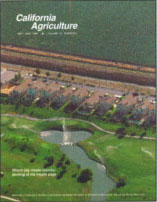All Issues
Readers respond to “Farming at the edge”
Publication Information
California Agriculture 52(5):4-4.
Published September 01, 1998
PDF | Citation | Permissions
Full text
Associate Editor's note:
Michal Moore's article (“Permissive growth policies may encourage speculative investment in farmland,” May-June 1998) examined the influence of Sphere of Influence (SOI) boundaries on land prices in Ventura County. For three of the five cities studied, Moore found per-acre farmland values — as measured by recent sales — were appreciably higher just outside the spheres than the countywide average for farmland in unincorporated areas. These cities also showed relatively high rates of growth. Moore concluded that in these cases, SOIs „do not provide a clear signal“ that development will stop at the sphere boundary.
One reader responded that Moore's data did not account for revisions in sphere boundaries around particular cities during the study period. Revisions that move boundaries outward and capture farmland previously outside the growth areas could, by themselves, generate higher values on such land. Author Moore has responded by expanding his analysis below.
Coincidentally, farmland and open space protection is a controversial issue on Ventura County's upcoming November ballot. Promoted by slow-growth advocates, eight separate measures are before the voters — six that call for urban growth boundaries around specific cities and two countywide dealing with farmland in unincorporated areas, greenbelts and further study.
Alvin D. Sokolow,
Associate Editor, California Agriculture
Author Michal C. Moore responds:
LAFCo establishes Sphere of Influence boundaries for each city and special district in anticipation of growth demands over a 20-year period. Boundaries are reviewed periodically. They can also be altered by request from a city.
In Ventura County, SOI boundaries have remained relatively constant since the middle 1980s. The LAFCo in Ventura County has been strict in maintaining existing boundaries and denying encroachment on farmlands. However, individual cities have evidenced different rates of growth. Changes of land use have occurred primarily within existing city boundaries or in annexed lands which were located within the Sphere of Influence.
This fact was used to test market reaction to the strength and commitment of public land use policy in the five cities. Evidence suggests two correlations exist. Among the five cities, we found a correlation between high amounts of farmland being proposed for inclusion in the spheres, and relatively low price differentials between land inside and immediately outside the spheres. The price differential was markedly less for those cities with greater growth pressures, Oxnard, Camarillo, and Ventura. (The “Save Our Agricultural Resources” initiative did not limit growth in the city of Ventura until 1995, after the period of data collection.)
We also found a correlation between increased land sale activity since 1985, and city requests for LAFCo approval of boundary changes.
Additional SOI findings include: (1) Values within each sphere area seem to represent urban conversion potential; (2) higher rates of land sales, combined with a lower pricing differential, seem to be found near cities with greater growth pressures.
Dear Editor:
I read with interest and dismay much of the May/June issue of California Agriculture (“Where City Meets Country…”).
As best I could tell, the word “immigration” never once appeared in the 40-page magazine. What is the point of the hand-wringing if no one is willing to even mention the underlying cause of virtually all of California's population growth? By the year 2030 or so, massive immigration will have generated a population density here equal to that of Communist China (of the one-child family).
Ben Zuckerman
Prof. of Physics and Astronomy, UCLA
Author Al Medvitz responds:
The set of articles that appeared in California Agriculture addressed the issue of state and local management of land use in the face of population growth. The origins of that population growth, in some senses, are irrelevant for the discussion. The primary question being addressed is: What are and have been the dynamics and consequences of agricultural land use policy in California under conditions of rapid population growth? This is not to say that population growth, and immigration's contribution to that growth are not problematic in California. They are and need to be addressed. But this was not the focus of the investigations.





